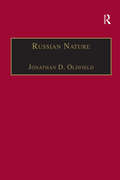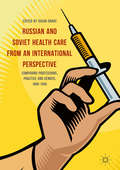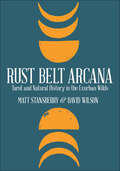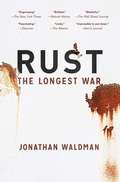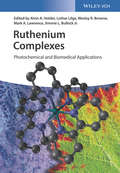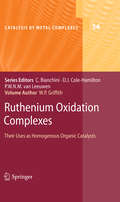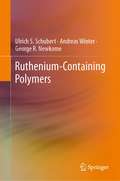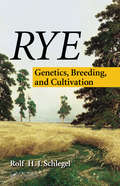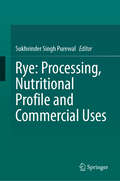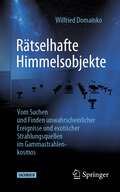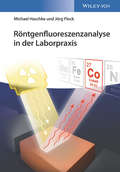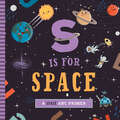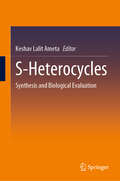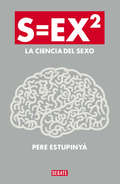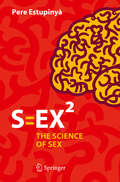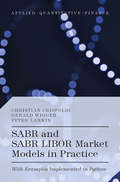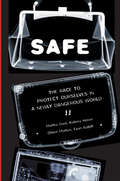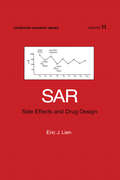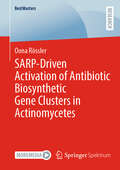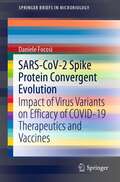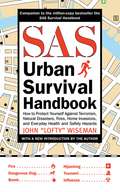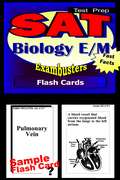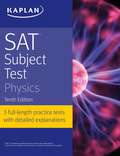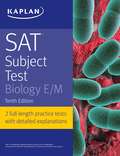- Table View
- List View
Russian Nature: Exploring the Environmental Consequences of Societal Change (Routledge Studies in Environmental Policy and Practice)
by Jonathan D. OldfieldJonathan D Oldfield provides a detailed assessment of the changing relationship between Russian society and the wider environment since the fall of the Soviet Union. Through this, he highlights the need to critically evaluate assumptions regarding the post-Soviet environment, in order to move beyond generalization and engage meaningfully with the particularities of Russia's contemporary environmental situation. The book begins by focusing on the nature of Soviet environmental legacies as a necessary backdrop to the remainder of the study. This is followed by a general examination of the relationship between economic change and pollution output during the course of the 1990s. Further chapters provide in depth analysis of recent legislative and policy developments in the area of environmental protection and an exploration of emerging pollution and environmental quality trends at both the national and regional level. In addition, the book highlights pressures that are related to Russia's engagement with the global economy.
Russian and Soviet Health Care from an International Perspective: Comparing Professions, Practice and Gender, 1880-1960
by Susan GrantThis collection compares Russian and Soviet medical workers – physicians, psychiatrists and nurses, and examines them within an international framework that challenges traditional Western conceptions of professionalism and professionalization through exploring how these ideas developed amongst medical workers in Russia and the Soviet Union. Ideology and everyday life are examined through analyses of medical practice while gender is assessed through the experience of women medical professionals and patients. Cross national and entangled history is explored through the prism of health care, with medical professionals crossing borders for a number of reasons: to promote the principles and advancements of science and medicine internationally; to serve altruistic purposes and support international health care initiatives; and to escape persecution. Chapters in this volume highlight the diversity of experiences of health care, but also draw attention to the shared concerns and issues that make science and medicine the subject of international discussion.
Rust Belt Arcana: Tarot and Natural History in the Exurban Wilds
by David Wilson Matt StansberryAn insightful take on the Tarot through the lens of the industrial Midwest, and a beautiful piece of nature writing in its own right. What can the Tarot tell us about the flora and fauna of the industrial Midwest? In what ways might this ancient practice connect us to the Rust Belt today? Rust Belt Arcana uses the Tarot&’s time-tested structure to answer these questions, juxtaposing the characteristics of the cards with the creatures and plants that surround us every day. The twenty-two idiosyncratic essays here—one for every card in the Major Arcana—bridge biology, natural history, and the human condition. They tell stories of abundance and loss, and they remind us of the Rust Belt&’s persistent remnant wilderness, a landscape often dismissed as unremarkable. A magical book both for Tarot enthusiasts and for those who are seeking to see beauty in a beleaguered landscape and define their remarkable place within it. &“Original and insightful. A vivid exploration of the beauty and brokenness of life&’s community. Stansberry&’s writing reveals the many surprising ecological, psychological, and cultural connections among human and beyond-human lives.&” —David George Haskell, Pulitzer finalist for The Forest Unseen &“A surprising, delightful book, filled with original insights about the rich diversity of nature in the Midwest. Highly recommended!&” —Kenn Kaufman, author of Kingbird Highway &“The essays in Rust Belt Arcana are like meditations from a parallel world —a magical place of nature which persists against all odds alongside the cities and subdivisions and highway interchanges of the Great Lakes region.&” —David Beach, GreenCityBlueLake Institute, Cleveland Museum of Natural History
Rust: The Longest War
by Jonathan WaldmanIt has been called "the great destroyer" and "the evil." The Pentagon refers to it as "the pervasive menace." It destroys cars, fells bridges, sinks ships, sparks house fires, and nearly brought down the Statue of Liberty. Rust costs America more than $400 billion per year--more than all other natural disasters combined.In a thrilling drama of man versus nature, journalist Jonathan Waldman travels from Key West, Florida, to Prudhoe Bay, Alaska, to meet the colorful and often reclusive people who are fighting our mightiest and unlikeliest enemy. He sneaks into an abandoned steelworks with a brave artist, and then he nearly gets kicked out of Ball Corporation's Can School. Across the Arctic, he follows a massive high-tech robot that hunts for rust in the Alaska pipeline. On a Florida film set he meets the Defense Department's rust ambassador, who reveals that the navy's number one foe isn't a foreign country but oxidation itself. At Home Depot's mother ship in Atlanta, he hunts unsuccessfully for rust products with the store's rust-products buyer--and then tracks down some snake-oil salesmen whose potions are not for sale at the Rust Store. Along the way, Waldman encounters flying pigs, Trekkies, decapitations, exploding Coke cans, rust boogers, and nerdy superheroes. The result is a fresh and often funny account of an overlooked engineering endeavor that is as compelling as it is grand, illuminating a hidden phenomenon that shapes the modern world. Rust affects everything from the design of our currency to the composition of our tap water, and it will determine the legacy we leave on this planet. This exploration of corrosion, and the incredible lengths we go to fight it, is narrative nonfiction at its very best--a fascinating and important subject, delivered with energy and wit.
Ruthenium Complexes: Photochemical and Biomedical Applications
by Wesley R. Browne Alvin A. Holder Lothar Lilge Mark A.W. Lawrence Jimmie L. Bullock Jr.Edited by a team of highly respected researchers combining their expertise in chemistry, physics, and medicine, this book focuses on the use of ruthenium-containing complexes in artificial photosynthesis and medicine. Following a brief introduction to the basic coordination chemistry of ruthenium-containing complexes and their synthesis, as well as their photophysical and photochemical properties, the authors discuss in detail the major concepts of artificial photosynthesis and mechanisms of hydrogen production and water oxidation with ruthenium. The second part of the text covers biological properties and important medical applications of ruthenium-containing complexes as therapeutic agents or in diagnostic imaging. Aimed at stimulating research in this active field, this is an invaluable information source for researchers in academia, health research institutes, and governmental departments working in the field of organometallic chemistry, green and sustainable chemistry as well as medicine/drug discovery, while equally serving as a useful reference also for scientists in industry.
Ruthenium Oxidation Complexes
by William P. GriffithRuthenium Oxidation Complexes explores ruthenium complexes, particularly those in higher oxidation states, which function as useful and selective organic oxidation catalysts. Particular emphasis is placed on those systems which are of industrial significance. The preparation, properties and applications of the ruthenium complexes are described, followed by a presentation of their oxidative properties and summary of the different mechanisms involved in the organic oxidations (e.g. oxidations of alcohols, alkenes, arenes and alkynes, alkanes, amines, ethers, phopshines and miscellaneous substrates). Moreover, future trends and developments in the area are discussed. This monograph is aimed at inorganic, organic, industrial and catalysis chemists, especially those who wish to carry out specific organic oxidations using catalytic methods.
Ruthenium in Catalysis
by Pierre H. Dixneuf Christian BruneauThe series Topics in Organometallic Chemistry presents critical overviews of research results in organometallic chemistry. As our understanding of organometallic structure, properties and mechanisms increases, new ways are opened for the design of organometallic compounds and reactions tailored to the needs of such diverse areas as organic synthesis, medical research, biology and materials science. Thus the scope of coverage includes a broad range of topics in pure and applied organometallic chemistry, where new breakthroughs are being achieved that are of significance to a larger scientific audience. The individual volumes of Topics in Organometallic Chemistry are thematic. Review articles are generally invited by the volume editors.
Ruthenium-Containing Polymers
by Andreas Winter Ulrich S. Schubert George R. NewkomeThis book presents the synthetic methodologies as well as the properties and potential usage of various ruthenium-containing materials. Starting from the first examples of 'ruthenopolymers' reported in the 1970s to the 3D architectures now synthesized, these materials have shown their importance far beyond fundamental polymer science. As well as highlighting the remarkable properties and versatile applications, this book also addresses a key question related to the applications of such heavy-metal-containing materials from the perspective of achieving a sustainable future. This book is of interest to both materials scientists and chemists in academia and industry.
Rye: Genetics, Breeding, and Cultivation
by Rolf H. SchlegelOwing to its considerable winter hardiness, rye is a cereal that played a major role in the feeding of European populations throughout the Middle Ages. Recent data shows that rye is grown on about 5.4 million hectares, with a world production of approximately 13 million tons. While still an important bread food in many countries, rye produced for b
Rye: Processing, Nutritional Profile and Commercial Uses
by Sukhvinder Singh PurewalCereal grains are gaining interest from food manufacturers and pharmaceutical industries because of their health benefits. In the current day consumers are focusing on diets rich in nutrients and bioactive compounds and researchers are exploring the potential of different cereal grains. Cereal grain possesses a unique blend of macronutrients and micronutrients. Among different cereal grains (wheat, rye, oats, rice, barley and sorghum) rye possess higher amount of arabinoxylan. Rye is the only crop after wheat which possess a significant amount of gluten proteins, and is widely used in food industries throughout the world for the preparation of products such as bread, biscuits, rusk, flakes and beer. Scientific reports on rye considered it an important dietary source as it has well balanced amino acid profile as compared to wheat. Rye grains possess an array of bioactive compounds with antioxidant potential that may help in immunity boosting and countering age-related issues. Rye istraditionally used for the preparation of bread in Northern and Eastern Europe. As a staple food, bread is enjoyed by major part of population, making its quality is of utmost importance. Being an important part of dietary menu, bread should have high nutritional quality. Nutritional profile indicates that bread is a rich source of fibers, proteins along with macro and micronutrients. Rye is a dual-purpose crop used as food and feed and has the potential to be used for medicinal purpose as it is a good source of fibers and antioxidants. Further, starch isolated from rye grains can be utilized as excipient during tablet preparation. Rye starch-based coatings are useful in enhancing the shelf life of fresh cut fruits and whole fruits. After wheat, rye is the only cereal grain which possess gluten, meaning its flour can be used in the preparation of protein and fiber rich bakery products. Rye: Processing, Nutritional Profile and Commercial Uses discusses the physical parameters and health benefiting features of rye, exploring the chemistry of rye components, rye flour and starch properties and proteins and their extraction and industrial uses, antioxidant properties, fiber profile and health benefits, rye flour based important food products and effect of processing on nutritional profile. This is the first scientific text available specifically on rye grains and provides the latest information and updates. Rye's different components such as starch, protein, fiber, bioactive metabolites and their uses in food products are described in detail. Chapters focusing on the specific components of rye grains and their health benefits are included, making this the go-to source for researchers looking for a singular and comprehensive overview of this beneficial crop.
Rätselhafte Himmelsobjekte: Vom Suchen und Finden unwahrscheinlicher Ereignisse und exotischer Strahlungsquellen im Gammastrahlenkosmos
by Wilfried DomainkoDieses Buch erzählt vom Suchen und Finden überraschender Phänomene im Licht der Gammastrahlenastronomie - und zeigt, was wir von noch rätselhaften Himmelsobjekten über das Universum und die Grenzen unseres Wissens lernen können.Das Universum ist von einer unvorstellbaren Zahl an Himmelskörpern bevölkert, von denen sich nicht wenige nach wie vor einer konventionellen Erklärung zu entziehen scheinen. Solche exotischen Strahlungsquellen finden sich besonders im Gammalicht. Anhand ausgewählter Beispiele widmet sich der Autor diesen anomalen Objekten. Er zeigt: Diese Objekte zeugen nicht nur von den extremsten Ereignissen im Kosmos, sondern könnten sogar auf eine bisher unbekannte Physik hindeuten. Und das nicht nur in fernen Ecken des Universums, sondern möglicherweise auch auf der Erde, wie anomale Spuren auf unserem Planeten zeigen. Anschaulich erklärt Wilfried Domainko die innovativen Methoden, die bei der Suche nach diesen exotischen Phänomenen zum Einsatz kommen – und wie die gefundenen Strahlungsquellen unser Weltbild verändern könnten.
Röntgenfluoreszenzanalyse in der Laborpraxis
by Michael Haschke Jörg FlockBereits seit vielen Jahren wird die Röntgenfluoreszenzenzanalyse eingesetzt für die Untersuchung kompakter, homogener Proben wie Metallen oder Gläsern, aber auch für die Analyse pulverförmiger Proben wie etwa geologische Proben, Zement und Eisenlegierungen. In den letzten Jahren haben sich viele neue Applikationsgebiete für diese Methode eröffnet. Im vorliegenden Buch erfolgt zunächst eine kurze Darstellung der physikalischen Zusammenhänge bei der Erzeugung und Wechselwirkung von Röntgenstrahlung in der zu untersuchenden Probe. Dann werden die verschiedenen Methoden der Probenpräparation in Abhängigkeit von der Qualität des Ausgangsmaterials sowie von der analytischen Zielstellung vorgestellt. Nach einer kurzen Beschreibung der verschiedenen Gerätetypen, die in der Röntgenanalytik existieren, und deren Leistungsfähigkeit wird auf die Auswahl optimaler Messbedingungen eingegangen sowie die Aufbereitung der Messdaten erläutert, angefangen von deren Korrektur über die Bestimmung der Intensitäten bis hin zum endgültigen Analysenergebnis, auch unter Berücksichtigung, Vermeidung und Korrektur möglicher auftretender Fehler. Nach einer kurzen Beschreibung der Gefahren einer Schädigung durch Röntgenstrahlung und der Anforderungen zu denen Verhinderung werden die verschiedenen Applikationen der Röntgenfluoreszenz beschrieben.
S Is for Space: A Space ABC Primer
by Ashley Marie MirelesAn out-of-this-world ABC primer from astronaut to zenith and beyond!
S-Heterocycles: Synthesis and Biological Evaluation
by Keshav Lalit AmetaThis book presents the recent research on sulfur-containing heterocyclic scaffolds that are crucial for biological processes. The numerous synthetic techniques utilized for the design and synthesis of different sized S-heterocycles, particularly biologically active frameworks with their pharmacological significance, are discussed in this book. This book is a useful reference for students, researchers and professionals working in the chemical and pharmaceutical industries.
S=EX2: La ciencia del sexo
by Pere EstupinyàUna aproximación al sexo innovadora y original que revolucionará nuestra mente y quizá también nuestro comportamiento. Tienes en tus manos el libro más riguroso, ameno, y completo jamás escrito sobre el fascinante estudio científico de la sexualidad humana. Por amor a la ciencia, Pere Estupinyà, el ladrón de cerebros, se sumerge en una novedosa investigación: participa en un estudio sobre disfunción eréctil y el orgasmo masculino, visita centros de referencia como el prestigioso Instituto Kinsey, se infiltra en clínicas de medicina sexual, acude a congresos internacionales de sexología, y entrevista a científicos expertos en sexualidad. Pero también habla directamente con asexuales, fetichistas, mujeres multiorgásmicas, anorgásmicas, intersexuales, pasa una noche en un club de swingers de Nueva York, participa en eventos sadomasoquistas, habla con actores y actrices porno, y acude a talleres donde una mujer enseña a tener orgasmos con la respiración y la mente. Todo esto acompañado de una revisión exhaustiva de bibliografía científica donde encuentra valiosas publicaciones sobre los procesos inconscientes de la atracción, el sexo online, nuestra naturaleza polígama versus la monógama, la relación entre el placer y el dolor, las disfunciones sexuales más frecuentes, y mucho más. En La ciencia del sexo encontrarás infinidad de anécdotas históricas, consejos prácticos, reflexiones profundas, y respuestas a qué nos ocurre cuando estamos disfrutando de la actividad que más nos interesa, pero que paradójicamente la ciencia tiene más reparos en explorar.
S=ex²
by Pere EstupinyàYou have in your hands the most rigorous, complete and readable book ever written about the fascinating science of human sexuality. This book goes beyond the well-wornsexual education advice and the usual evolutionist psychology. After The BrainSnatcher, Pere Estupinyà comes back with the first popular science book on sexaimed at a wide audience. While there are some tips for the more adventurous, thereis also a wealth of new information to be discovered. Distancing himself from the manybooks on advice or techniques, Estupinyà brings sex to another dimension bycombining popular beliefs and science. Do you want proof that ourdecision-making in the "heat of the moment" is less rational than we think? Didyou know that mind and vagina each go their own way? Are you interested inlearning about the effects of yoga on sexual pleasure? Did you know about theattempts in the 60s to "cure" homosexuals with electric shock therapy, thechemical analysis of female ejaculation, or the fundamental relationshipbetween the sympathetic and parasympathetic nervous system? The author hasspoken directly with asexual and intersexual individuals, fetishists,multi-orgasmic women, women who never have orgasms through penetration, and menwho have no refractory period. He has also participated in sadomasochisticevents; learned tantric techniques with a couple of coaches, spoken with pornperformers at Barcelona's Bagdad, and attended workshops in which a womanteaches how to have orgasms with your mind and breathing. The result is anincredible miscellany of information that appeals to both the scientificcommunity and the curious.
SABR and SABR LIBOR Market Models in Practice: With Examples Implemented in Python (Applied Quantitative Finance)
by Peter Larkin Christian Crispoldi Gérald WiggerInterest rate traders have been using the SABR model to price vanilla products for more than a decade. However this model suffers however from a severe limitation: its inability to value exotic products. A term structure model à la LIBOR Market Model (LMM) is often employed to value these more complex derivatives, however the LMM is unable to capture the volatility smile. A joint SABR LIBOR Market Model is the natural evolution towards a consistent pricing of vanilla and exotic products. Knowledge of these models is essential to all aspiring interest rate quants, traders and risk managers, as well an understanding of their failings and alternatives. SABR and SABR Libor Market Models in Practice is an accessible guide to modern interest rate modelling. Rather than covering an array of models which are seldom used in practice, it focuses on the SABR model, the market standard for vanilla products, the LIBOR Market Model, the most commonly used model for exotic products and the extended SABR LIBOR Market Model. The book takes a hands-on approach, demonstrating simply how to implement and work with these models in a market setting. It bridges the gap between the understanding of the models from a conceptual and mathematical perspective and the actual implementation by supplementing the interest rate theory with modelling specific, practical code examples written in Python.
SAFE: Science and Technology in the Age of Ter
by Martha Baer Katrina Heron Olivia Morton Evan RathffIf our society is the most technologically sophisticated on Earth, then why can't we protect ourselves from terrorists and other threats to our safety and security? This is the question that frustrates—and scares—all of us today, and the answers have proved maddeningly elusive. Until now. Through dramatic, enlightening, and often entertaining narratives, SAFE makes visible—and understandable—the high-stakes work being done by some of the most ingenious problem-solvers across the country and around the world, people committed to creating real and dependable security in the twenty-first century.The characters in these pages, from scientists and engineers to academics, entrepreneurs, and emergency workers, take us into a fascinating world of inquiry and discovery. Their stories reveal where our greatest vulnerabilities lie and where our best hope deservedly shines through. They show why the systems we rely on to protect ourselves can also be exploited by others to create catastrophe—and what we can do to outsmart the terrorists. We have ample proof that terrorists will go to great lengths to understand how our technologies can be put to destructive use. Now it's time to ask ourselves a question: Are we willing to let them keep beating us at our own game? For the brilliant and colorful innovators in these pages, the answer is no.Among them are Eric Thompson, an expert digital code breaker instrumental in deciphering hidden Al Qaeda messages; Mike Stein, a New York City firefighter turned technologist who is working to overcome the numerous communications failures of 9/11; Eve Hinman, who conducts structural autopsies at the scene of explosions, including the Oklahoma City bombing, in order to develop more blast-resistant designs; Ken Alibek, the infamous architect of the former Soviet bioweapons program and now an American entrepreneur working in the business of defending his adopted country from bioterrorism; Kris Pister and Michael Sailor, university researchers developing sensors no larger than a speck of dust; Rafi Ron, former head of security for Ben Gurion Airport in Tel Aviv and now a leading strategist on U.S. airport security; Tara O'Toole, who stages doomsday bioterror scenarios in order to craft better biodefense systems; and Jeff Jonas, a high-rolling Las Vegas software entrepreneur whose methods for spotting casino cheats might just have uncovered the 9/11 plot.Readers of SAFE will come away understanding the unique challenges posed by technological progress in a networked, and newly dangerous, world. Witnessing the work of this gathering force of innovators up close, they'll be inspired by the power of the human intellect and spirit—and realize how important the contributions of individual citizens and communities can be.
SAR: Side Effects and Drug Design
by Eric J. LienThis book focuses on the quantitative structure-activity relationship of the disposition and activities of various pharmacological groups. It presents a systematic approach for linking different side effect of drugs to their molecular structure and physiochemical properties.
SARP-Driven Activation of Antibiotic Biosynthetic Gene Clusters in Actinomycetes (BestMasters)
by Oona RösslerActinomycetes are a group of Gram-positive bacteria of which many representatives are prominent for being prolific producers of bioactive natural products including antibiotics, fungicides, antitumor agents, or immunosuppressants. SARP transcriptional regulators are widely distributed among actinomycetes, especially in streptomycetes and are known to activate antibiotic biosynthesis. The set of genes responsible for the production of natural products, including pathway specific transcriptional regulators such as SARPs, are typically located in contiguous regions of the genome known as "biosynthetic gene clusters" (BGCs). In this book, Oona Rössler reports on the activation of antibiotic BGCs in selected actinomycetes strains upon heterologous expression of the SARP-type regulator PapR2 from Streptomyces pristinaespiralis. Applying a bioinformatic screening for the abundance of SARP genes and SARP consensus sequences as part of BGCs, the author has selected actinomycetes candidate strains from the DSMZ strain collection for heterologous SARP expression. It is shown that overexpression of papR2 increased the production of predominantly unknown antimicrobial compounds in more than half of the selected actinomycetes strains, as observed by bioassays against different microbial test strains including bacteria and fungi.
SARS-CoV-2 Spike Protein Convergent Evolution: Impact of Virus Variants on Efficacy of COVID-19 Therapeutics and Vaccines (SpringerBriefs in Microbiology)
by Daniele FocosiThis book reviews the current knowledge of the globally circulating SARS-CoV-2 variants, highlights their distinct genetic characteristics and associated conformational changes in the viral spike protein, and profoundly discusses the mechanisms of convergent evolution that led to the rise of these mutated strains at different geographic regions during the Covid-19 pandemic. Furthermore, the book explores how these variants do and may impact the efficacy of established neutralizing antibody-based (nAb) vaccines and therapeutics by analysing latest in vivo and in vitro clinical data. Finally, the author discusses ways on how nAb Covid-19 treatment derived immune escape of SARS-CoV-2 could be minimized in the future.
SAS Urban Survival Handbook: How to Protect Yourself Against Terrorism, Natural Disasters, Fires, Home Invasions, and Everyday Health and Safety Hazards
by John Lofty" WisemanJohn "Lofty" Wiseman is the author of the bestselling SAS Survival Handbook, the definitive guide to survival in the wild from Britain's Special Air Service. Now he has compiled a complete guide to survival in the urban jungle. Every year in America there are thousands of fatal accidents in the home—more than on the roads, and many more than in the great outdoors. Fire, electricity, water, gas, sharp knives, poisons, chemicals—these valuable tools can quickly become dangerous weapons when not treated with proper respect and understanding. Add to these the risks of travel, terrorism, muggings, rape, tsunamis, and earthquakes. We are constantly reminded that the world is a dangerous place. Wiseman shows readers how to think realistically and practically about these perils in order to avoid them, whether they are at home, on the street, in school, or in transit. From self-defense techniques to home security systems to coping with natural disasters, this book will teach readers to recognize risks, make quick decisions, and live confidently in the modern urban world.
SAT Biology E/M Test Prep Review: Exambusters Flash Cards and SAT II Exam Study Guide (Exambusters SAT 2 #1)
by Ace Inc.<P><P><i>Advisory: Bookshare has learned that this book offers only partial accessibility. We have kept it in the collection because it is useful for some of our members. Benetech is actively working on projects to improve accessibility issues such as these.</i><P><P> SAT BIOLOGY E/M Study Guide:<P><P> 450 questions and answers. Essential definitions and concepts. Topics: Cells, Biochemistry and Energy, Evolution and Classification, Kingdoms: Bacteria, Fungi, Protista; Kingdom: Plantae, Kingdom: Animalia, Human Locomotion, Human Circulation and Immunology, Human Respiration and Excretion, Human Digestion, Human Nervous System, Human Endocrinology, Reproduction and Development, Genetics, Ecology. <P> EXAMBUSTERS SAT II Prep Workbook:<P> Provides comprehensive SAT II review--one fact at a time--to prepare students to take practice SAT II tests. Each SAT II study guide focuses on fundamental concepts and definitions--a basic overview to begin studying for the SAT II exam. Up to 600 questions and answers, each volume in the SAT II series is a quick and easy, focused read. Reviewing SAT II flash cards is the first step toward more confident SAT II preparation and ultimately, higher SAT II exam scores!
SAT Subject Test (Tenth Edition): Physics
by Hugh HendersonKaplan's SAT Subject Test Physics is the most up-to-date guide on the market with the essential content, practice, and strategies students need for success on Test Day. Kaplan's expert tips and focused review will help you ace the test and give your college applications a boost.<P><P> Contents: Essential Review; Three full-length practice tests with detailed answer explanations; A full-length diagnostic test identifies areas for score improvement so you can personalize your prep; Focused chapter summaries, highlights, and quizzes; End-of-chapter quizzes for additional practice; Proven score-raising strategies teach you how to tackle the test efficiently; Expert Guidance. <P>We know the test: Our Learning Engineers have put tens of thousands of hours into studying the SAT – using real data to design the most effective strategies and study plans. Kaplan's expert psychometricians make sure our practice questions and study materials are true to the test.We invented test prep—Kaplan (www.kaptest.com) has been helping students for almost 80 years, and more than 95% of our students get into their top-choice schools. Our proven strategies have helped legions of students achieve their dreams.
SAT Subject Test Biology E/M
by KaplanEssential strategies, practice, and review to ace the SAT Subject Test Biology E/M Getting into a top college has never been more difficult. Students need to distinguish themselves from the crowd, and scoring well on an SAT Subject Test gives students a competitive edge. Kaplan’s SAT Subject Test Biology E/M is the most up-to-date guide on the market with complete coverage of both the content review and strategies students need for success on Test Day. Kaplan’s SAT Subject Test Biology E/M features: * A full-length diagnostic test * 2 full-length practice tests * Focused chapter summaries, highlights, and quizzes * Detailed answer explanations * Proven score-raising strategies * End-of-chapter quizzes Kaplan is serious about raising students’ scores—we guarantee students will get a higher score, or get their money back.
